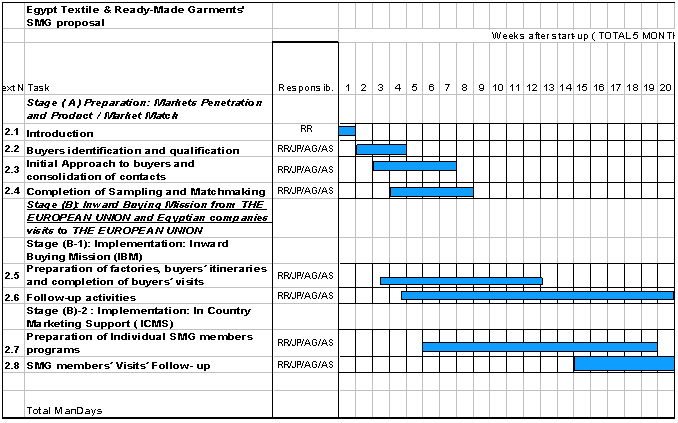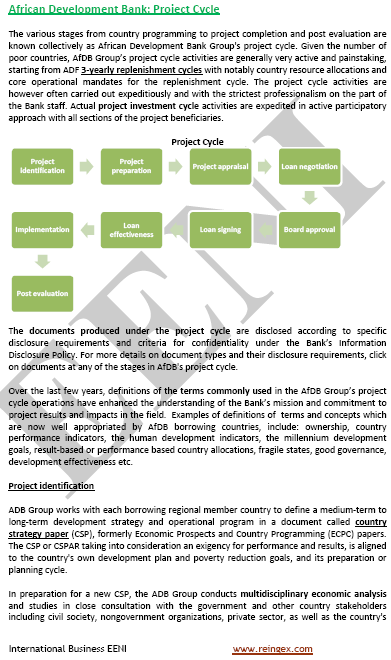Project Cycle Management

Project Cycle Management of Development Projects
- International Development Project Cycle
- In-depth review of the Project Cycle Management (PCM) and the Logical Framework Approach and its Phases and Documents
- Project Identification and its Tools
- Project Formulation or Appraisal and its Tools
- Project Description or “Fiches” and Drafting Terms of Reference or Statements of Work
- Project Implementation, Monitoring, and Evaluation
- Fundamentals of Financial and Economic Analysis (ECO-FIN) and other Methodologies of Financial Appraisal
- Conclusions and Review
Languages:  and /or
and /or  Master Comercio Exterior
Master Comercio Exterior  Master Commerce International.
Master Commerce International.
Description (Project Cycle Management).
Objectives.
- Knowing all terminology relating to projects of the different Multilateral Funding institutions
- Carrying out a general analysis of EC Management Cycle and identifying projects tools
- Controlling all the issues of Logical Framework: indicators, means of verification, hypotheses, and risk analysis
- Carrying out an Economic and Financial Analysis (Eco-Fin)
In this subject; we will study the Logical Framework Approach (LFA) and the Project Cycle Management of various institutions.
We will analyze everything relating to these public Project Management instruments, focusing on the differences and similarities of the different Multilateral Funding institutions, as well as in the economic financial analysis (Eco-Fin) a complement to these previously described tools.
The EC takes part in development cooperation (external actions) using three mechanisms: Direct support to projects, sector budget support, and Macroeconomics support. Project support is carried with the methodology of Project Cycle Management. The graph below shows the stages and documents of this approach:



The Logical Framework Approach (LFA) is a series of techniques used for identifying the key problems and objectives that the project wants to address and project then proceeds to a detailed formulation of the project. It is also used for consulting and involving stakeholders as much as possible.
The Logical Framework Approach is an analytical process, as well as a series of tools to support planning and project management and monitoring. It allows information to be analyzed and organized according to its importance and then the project to be designed. Moreover, it allows to identify options or alternatives and support decision-making for allocating resources and activities.
The Logical Framework Matrix is the matrix-shape result and summary of these analyses of the project, and consists of four columns and four rows, which summarize the key elements of a project before, during and after executing (it is possible to change or keep still the matrix throughout the project).
- The first column of the Logical Framework Matrix describes that aspect of the level of the project; it is also known as Intervention Logic.
- The second and third columns are the indicators and the principal means of verification for monitoring and assessing and belong to the so-called Horizontal Logic.
- The fourth column: Hypotheses or Assumptions are the external factors, which have the power to influence the success of the project, but are outside the direct control of the project management. They belong to the so-called Vertical Logic.
For the project identification we will consider the following stages:
- Stakeholders analysis.
- Problems analysis.
- Objectives analysis.
- Strategies/alternatives analysis.
- Description of the project and schedule, budget, risks.
Each of the steps inside of the Logical Framework Approach is important because they help us to define an aspect of the project and its future implementation.
Last but not least; we review the key concepts related to the Economic and Financial Analysis (Eco-Fin) of development projects, according to the European Commission external programme. It focuses on the point of view of the institution or a Group of institutions (beneficiary, Target Group). This is done using the Cost-Benefit Analysis or Cost-Effectiveness Analysis, depending on whether the benefits have an economic impact or not.
For carrying out the Economic and Financial Analysis (Eco-Fin); we need to imagine the parameters we want to analyze to a certain degree, and model the underlying economics of the sector and products/services. Furthermore, we need To understand the desired level of analysis and the “economic” certainty that key stakeholders or beneficiaries “will accept” (depending on their function, education and their role as Executive agency, EC Delegation or Washington or Brussels HQ offices).
